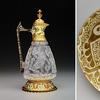Freer Gallery reveals light-filled Whistler's Peacock Room
- August 17, 2011 11:48
For the first time in 25 years, the Smithsonian’s Freer Gallery of Art will open the shutters of James McNeill Whistler’s famed Peacock Room for public view on the third Thursday of each month, beginning Aug. 18, 12-5:30 p.m. Visitors to the room will have a chance to experience the tonal subtleties and decorative variations of Whistler’s “harmony in blue and gold” visible only in natural sunlight.
The Washington, DC, museum installed ultraviolet- and visible-light-filtering film on the windows, allowing visitors to see the beauty of the room in natural light while minimizing the effects of light fading. Peacock motifs that would ordinarily blend into the background, along with the glazed surfaces and complex textures of ceramics on display, are clearly visible. In the light-filled interior, the ghostly presence of the embossed patterns of the room’s leather wall hangings, which were part of the design created by the room’s architect, Thomas Jeckyll, and later covered in Prussian blue paint by Whistler, is discernable.
The Thursday series is offered in conjunction with The Peacock Room Comes to America exhibition and will continue through spring 2013.
The Peacock Room has been restored to its appearance in 1908, when museum founder Charles Lang Freer used it to organize and display more than 250 ceramics he had collected from throughout Asia. As the first special exhibition held in the room since it underwent conservation in 1993, The Peacock Room Comes to America highlights Freer's belief in "points of contact" between American and Asian art and the aesthetic relationships to be found among the museum's diverse collections.
The Peacock Room was originally designed by architect Thomas Jeckyll for British shipping magnate Frederick Leyland, who wanted a place to showcase his blue-and-white Chinese porcelain collection in his London home. When American expatriate artist James McNeill Whistler redecorated the room in 1876 and 1877 as a "harmony in blue and gold," he was inspired by the delicate patterns and vivid colors of the Chinese porcelains. Their slick surfaces, however, did not appeal to Freer, who favored complex surface textures and subtly toned glazes. After he purchased the Peacock Room and moved it from London to his mansion in Detroit in 1904, Freer filled the shelves with pots he had acquired from Egypt, Iran, Japan, China, and Korea. The current presentation of works is based on photographs taken in Freer's Detroit residence in 1908.
Much like the room's arrangement in Detroit more than a century ago, this exhibition underscores Freer's belief that "all works of art go together, whatever their period." That faith in cross-cultural aesthetic harmonies achieved its ultimate expression in the Freer Gallery of Art, which opened to the public in 1923. Whistler's imaginative interior, now fittingly located between galleries of Chinese and American art, embodies the meeting of East and West.






100x100_n.jpg)



100x100_c.jpg)










